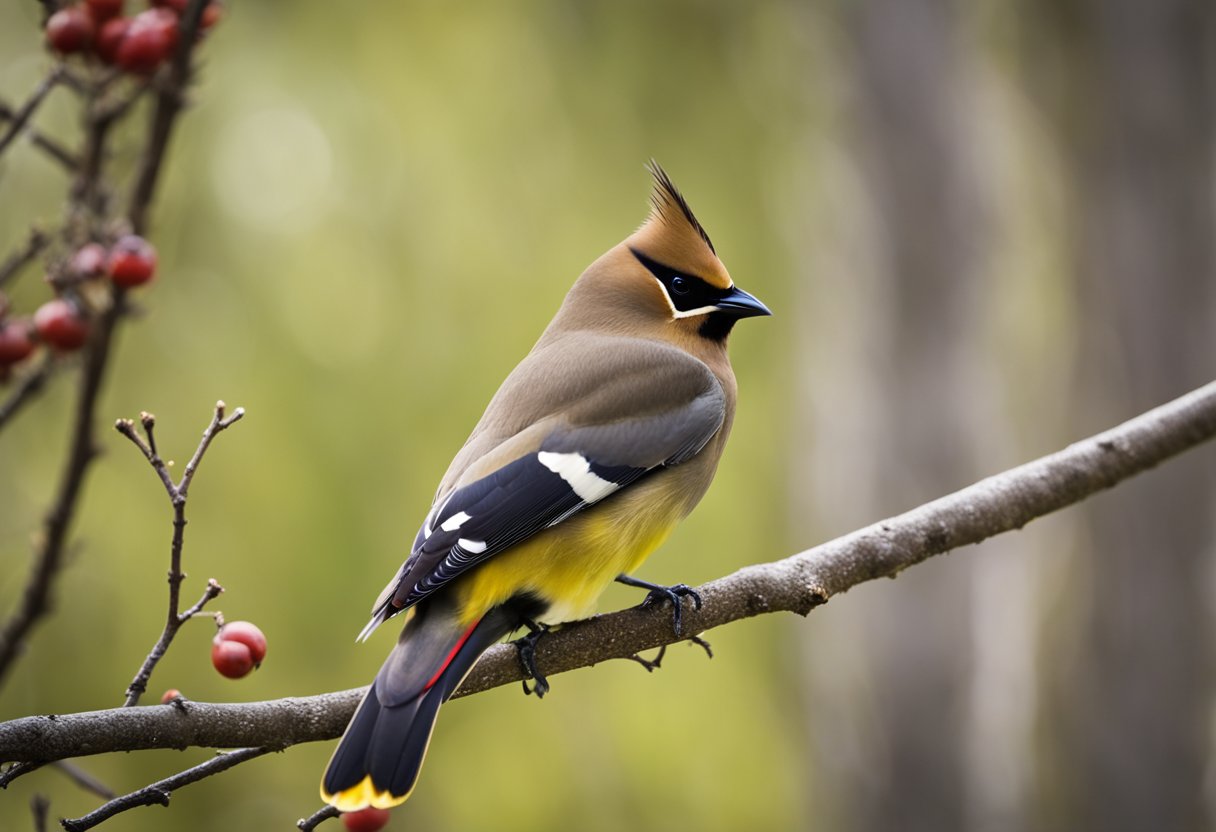Identification and Physical Characteristics
The Cedar Waxwing is a distinctive bird known for its sleek appearance and vibrant plumage. This section provides a closer look at its visual identification features and size comparisons with other species.
Visual Identification
Cedar Waxwings exhibit a striking combination of colors. Their bodies are predominantly gray with a brown and tan hue on the wings. Notable characteristics include a black mask that stretches across the eyes, adding to their elegant appearance. The yellow belly is complemented by a subtle white tip on the tail, which often features red wax-like markings on the wing edges.
The crest on the head varies among individuals, adding further distinctiveness. Adult Cedar Waxwings are typically richer in color compared to juveniles, which tend to display a more muted palette. This colorful appearance is essential for identification in the field, especially when viewing them in mixed flocks.
Size and Shape Comparisons
In terms of size, Cedar Waxwings measure about 6.5 to 8 inches in length, making them medium-sized birds. Their wingspan ranges from 9.8 to 12.2 inches, allowing for agile flight. The overall body shape is streamlined, with a slightly rounded tail that aids in their maneuverability.
When comparing them to similar species, they are larger than warblers but smaller than many sparrows. Their elongated bodies and distinct crests distinguish them from other birds in their habitat. With a solid physique, Cedar Waxwings have a graceful presence in both urban and natural settings, often seen feeding on berries.
Behavior and Habitat

Cedar Waxwings exhibit unique behaviors that reflect their social nature and adaptability to various habitats. Understanding their feeding habits, breeding practices, and seasonal movements provides insights into their life history.
Feeding Behavior and Diet
Cedar Waxwings primarily feed on fruits and berries, showing a strong preference for items like cherries, mulberries, and dogwood. They often forage in large flocks, which allows them to consume food quickly and efficiently.
Insects, particularly during the breeding season, also comprise a significant part of their diet. Waxwings catch flying insects like ants and aphids mid-air. Their diet varies seasonally, with an emphasis on fruit during winter months when insects are less available.
Breeding and Nesting
Breeding typically occurs from late spring to early summer. Cedar Waxwings choose sites for their nests in dense shrubs or trees, often near edges of woodlands. They construct a cup-shaped nest, using twigs, grass, and plant fibers.
Courtship behaviors involve males displaying their colorful plumage and feeding females, which strengthens pair bonds. The female usually lays 3-6 eggs, with parents sharing incubation responsibilities. The young fledge about two weeks after hatching, quickly learning to forage alongside their parents.
Seasonal Movements and Migration
Cedar Waxwings are generally nomadic, showing irregular migration patterns based on food availability. They can be found in varying geographical regions during different seasons.
In winter, they migrate to areas with abundant fruiting trees, often congregating in urban gardens or orchards. During spring and summer, they return to breeding grounds in open woodlands. Their movements are influenced by climate and local food sources, leading to large flocks during migration.
Taxonomy and Distribution
Cedar Waxwings belong to the family Bombycillidae and exhibit a specific range across North America and parts of Central America. Their classification highlights notable characteristics and variations between related species.
Conservation and Population
The conservation status of the Cedar Waxwing is currently assessed as stable, but habitat loss poses a potential threat. These birds thrive in areas with abundant fruit-bearing trees, such as berry bushes and orchards.
Population estimates suggest they are relatively abundant, though some fluctuations occur based on seasonal factors and food availability.
In the United States, they are commonly seen in urban parks and residential areas. Monitoring programs help track their population dynamics and habitat preferences.
Species Classification
Cedar Waxwings are classified under the genus Bombycilla, with the scientific name Bombycilla cedrorum. This species is closely related to the Bohemian Waxwing, belonging to the same family, Bombycillidae.
The taxonomy of Cedar Waxwings includes the following hierarchical structure:
- Kingdom: Animalia
- Phylum: Chordata
- Class: Aves
- Order: Passeriformes
- Family: Bombycillidae
- Genus: Bombycilla
- Species: Bombycilla cedrorum
Their distribution extends primarily throughout North America, particularly in Canada and the northern United States, with migrations noted to Central America during winter months.
Mapping their population and range illustrates a preference for deciduous and mixed forests, showcasing their adaptability in various environments.
Share this content:

Post Comment
You must be logged in to post a comment.